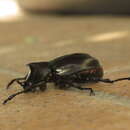en
names in breadcrumbs


Xylotrupes ulysses, common names "Elephant beetle", "Coconut palm beetle",[2] "common rhinoceros beetle" or simply "rhinoceros beetle"[3][4] is a species of rhinoceros beetle native to New Guinea. Male horns in several groups of this genus represent a special secondary sex characteristic. There is a bimodal horn-size distribution and there is a discrete male mating behavior correlated with each phenotype.[5]
Xylotrupes ulysses, common names "Elephant beetle", "Coconut palm beetle", "common rhinoceros beetle" or simply "rhinoceros beetle" is a species of rhinoceros beetle native to New Guinea. Male horns in several groups of this genus represent a special secondary sex characteristic. There is a bimodal horn-size distribution and there is a discrete male mating behavior correlated with each phenotype.